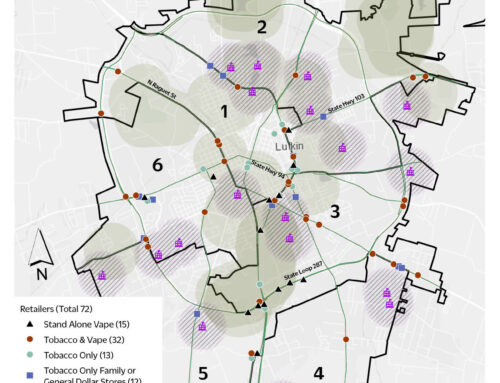Over the last few years, several corporate-owned chains and franchise stores have made commitments to reducing youth tobacco access. Conversely, other franchises have started selling tobacco, which has increased tobacco retailer density in some regions. These changes can have a significant impact on a community’s tobacco retail market depending on the geographic location of that community.
It’s amazing what we can gather about a community from the businesses that thrive there. In many rural communities across America, for example, a few key businesses can have a significant impact on the health and well-being of that community.
We know that place matters for our health. The number and type of tobacco retailers where we live, work, play and worship are one of the conditions that can be helpful or harmful for our health, and the tobacco retail landscape can vary greatly depending on the geographic location of our community.
Even before federal law raised the sales age for all nicotine and tobacco products to 21 in December, several corporate-owned chains and franchise stores were already taking action to reduce youth tobacco access:
- Beginning in September 2019, Walgreens raised the purchase age for tobacco products in stores nationwide to 21.
- Following the announcement by Walgreens, Rite-Aid made a similar move and announced they were also raising the age to buy tobacco in their stores to 21. They also announced they would stop selling e-cigarettes in their stores but will continue to sell tobacco products such as cigarettes and cigars.
- Walmart also raised the age to buy tobacco in their stores to 21, starting July 1, 2019. At the same time, they discontinued the sale of “fruit and dessert-flavored” e-cigarettes.
These announcements came shortly after the FDA reported in March 2019 that they had taken new actions to warn Walgreens and 15 other corporate-owned chains and franchise stores, including Walmart, with tobacco sale violation rates greater than 15%.
These commitments by national corporations are especially valuable as the FDA works to update their enforcement protocols to align with the new federal law. Decisions to reduce youth access by nationwide chains offer a glimpse at the impact we could see as a result of federal tobacco legislation, such as raising the minimum legal sales age. For example, in 2014, CVS became the first retail pharmacy chain in the U.S. to stop selling tobacco products. Following the chain’s removal of tobacco products from its stores, total cigarette purchases in states where CVS holds significant market share declined by 1%, and smokers who had previously purchased their cigarettes exclusively at CVS were up to twice as likely to stop buying cigarettes entirely.
However, these actions are only the beginning of what is needed to address youth access to tobacco. In a move in the opposite direction, Family Dollar and Dollar General started selling tobacco in late 2012 and early 2013, which increased tobacco retailer density in some regions, even after CVS ended sales. A recent study conducted in six southeastern states found that this resulting increase in retailer density impeded progress in smoking reduction.
This points to the need for local action to limit access to tobacco in other ways, such as by requiring a license to sell tobacco and setting a cap on the total number of tobacco retailer licenses allowed in a jurisdiction. We know that tobacco retailer licensing systems, particularly at the local level, allow better monitoring of retailer compliance and allow for a wider range of penalties, including having a retailer’s license to sell tobacco products suspended or revoked for repeated violations.
There is much more we can do right at our backdoor to shape the future of businesses in our community and provide a healthier retail environment.
This post was originally published as a feature article for The Geographic Health Equity Alliance (GHEA), a CADCA initiative. GHEA is a CDC funded National Network dedicated to reducing geographic health disparities related to tobacco and cancer.





